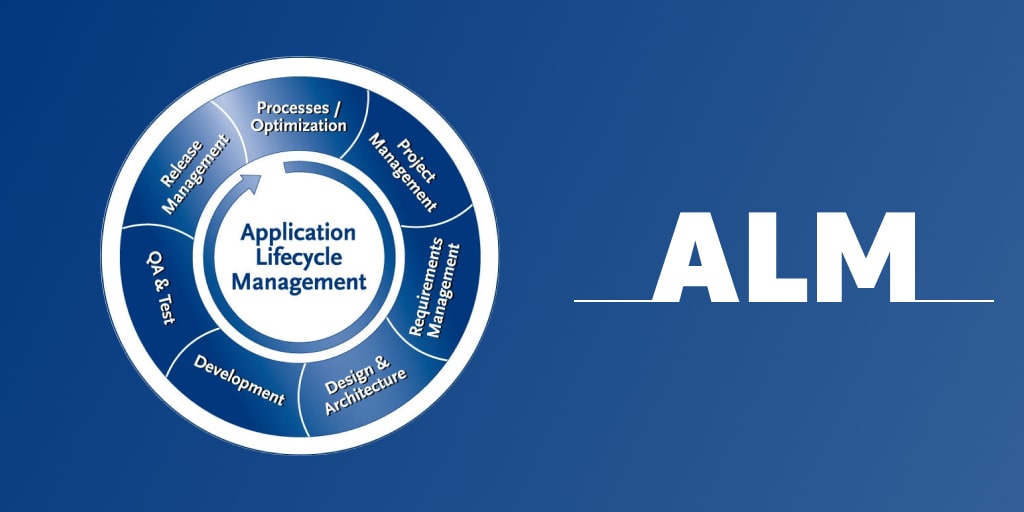All products go through a standard development process, advancing from one stage to another. The same is true for the software development process. To control its settings and sub-processes, various disciplines are involved, each fulfilling specific functions: project management (PM), product development, QA & testing, service delivery, and support. These stages are interdependent and performed in continuous collaboration to enhance efficiency and output. So, what is ALM in software testing?
Application Lifecycle Management — Basic Concepts
Application Lifecycle Management (ALM) refers to integrating all these functions into one comprehensive lifecycle. Essentially, ALM tools create a structured and flexible environment for collaboration between departments, accelerating and enhancing the effectiveness of the product development cycle and its phases.
A more extended definition of ALM includes a set of tools and methods for vital and efficient team collaboration. These tools increase visibility at each point of the software development life cycle and expedite task transfers between teams. Efficient ALM application increases the chances for faster market entry and enhanced software quality. Moreover, ALM significantly contributes to each team member’s understanding of overall purposes and requirements.
Application Lifecycle Management Strategy
ALM encompasses all development and management operations. However, it is essential to distinguish between product lifecycle management and ALM — the former is more complex and deals with numerous modifications in a short span.
ALM combines the goals and mechanisms of both business and software engineering. Application lifecycle management is executed using efficient integrated tools that facilitate requirements specification and compliance, product management, coding, QA, and release.
What Are the Common Stages in Application Lifecycle Management?
ALM is typically divided into three phases: governance or requirements, development (including QA & testing), and operation & maintenance. However, the number and components of these stages may vary. Let's explore some stages of ALM in detail.
Requirements
This stage involves gathering all types of requirements — legal, technical, financial, or general business. It also includes designing the application according to these requirements.
ALM tools must provide necessary functionality and adapt to the team's processes, especially in regulated environments or process-oriented sectors. These tools facilitate planning and estimates, whether for Agile or classical waterfall projects.
In some classifications, there is a separate design management stage that enhances software usability and customer satisfaction levels.
Development
In this phase, the idea is transformed into the application itself, involving testing, modifications, and deployment. This process may be repeated multiple times until the app is ready for release.
While coding is not typically considered a component of ALM, it is the core of application development. Therefore, source code management functions must be incorporated into ALM tools to ensure compliance tracking during testing and flaw correction.
Software configuration management (SCM) is sometimes seen as a separate ALM phase, arranging, monitoring, and handling code modifications, documentation, and other development cycle elements.
QA & Testing
If you're wondering, "What is ALM in software testing?" and its impact on the QA stage, ALM stands out by incorporating QA and testing as essential elements of the software development process.
ALM tools provide complete requirements traceability and timely validation. One key characteristic of ALM is the early involvement of the QA team, allowing testers to authorize test plans and understand conditions from the start.
Critical ALM test management characteristics include:
- Test progress tracking and control.
- Identifying app weaknesses and flaws.
- Regular inspection and confirmation of requirements.
- Integration with the current ecosystem.
Specific ALM tools support automated and multi-platform testing. Therefore, the chosen ATM tool must be compatible with both automated and manual testing. Understanding the type of applications to be tested is crucial to ensure the tool meets testing requirements.
Operations
Operations, followed by maintenance, is the phase where deployed software or applications are managed. This stage includes additional testing and bug resolution, prioritizing subsequent product updates.
Another testing round ensures the app aligns with users’ expectations and supporters’ needs to move further in the lifecycle.
UX or maintenance is often the final ALM substep, typically the longest. This phase involves customer reviews, testing the entire app, and providing feedback for improvements.
How Application Lifecycle Management Works
Application lifecycle management allows all team members, managers, and even sponsors to participate actively in:
- Specifying requirements, managing them, and ensuring compliance.
- Setting and monitoring work processes.
- Managing and adjusting coding, QA, and maintenance procedures.
- Confirming that testing meets functionality, performance, usability, and security needs.
ALM promotes proper, smooth, and swift arrangement and administration of all application lifespan steps.
What Is the Advantage of Application Lifecycle Management (ALM)
ALM offers numerous benefits for your development team and business, including:
- Accelerated app lifecycle processes and releases.
- Higher quality of the final product.
- Enhanced traceability.
- Improved visibility.
Proving requirements compliance is challenging. The ultimate strength of ALM tools lies in their ability to build a traceability matrix and monitor compliance at all stages. With ALM, teams gain total visibility, keeping everyone up-to-date on procedures and knowing which requirements are fulfilled and which remain.
Bottom Line
Using application lifecycle management techniques and tools leads to more effective release plans and top-quality product launches in the shortest terms. ALM ensures that your team sees the big picture at every stage of the software development project, thanks to a proper collaboration system, consistent information, and complete visibility. This approach helps avoid inefficient task transfers between departments, unexpected bugs, or non-compliance with initial requirements.
